You quite possibly have lived with 24-hour news networks your entire life, however there was a time not all that long ago that newscasts were mainly shown at designated times. For almost forty-years, the network nightly newscast was a staple in most homes in our country. News anchors were highly respected figures, the keepers of the information that spanned the globe, the men whose job it was to tell us what was happening with national and world figures. How once again we made it through a span of 24-hours without the planet stopping its daily rotation around the sun. They showed us the triumphs and the tragedies, the acts of the great and powerful as well as the conditions of our weakest and most vulnerable. Telling their viewers of stories from Anytown, USA to the Far East.
Television presented the networks national newscasts right after the dinner hour (usually 6:30 pm or 7:00 pm EST dependent on the market) so that the family could catch up on the world’s events, before airing their prime-time lineup. Network affiliates would then broadcast their local newscast at 11:00 pm, which more times than not were the same stories that were on earlier that evening. However if a major story did occur during prime-time hours, the networks would break away from normal programming to alert viewers. There were many times over the decades that regular programming would be suspended for the evening due to a national tragedy.
Back in the days that the networks ruled the airwaves, the news division would fight the entertainment division for air-time. Despite the high and lofty hopes of many in television’s infancy, the medium’s main function was to entertain the viewers. That was what sold soap and deodorant which is the way they paid the bills. It did not prevent however a strong presence by all three networks news divisions, as “NBC White Papers” and “CBS Reports,” an ongoing series of specials dug deeply into the issues of the day. Although the shows never garnered large ratings, it fulfilled the networks public service obligations and earned them good will from many corners.
The Sixties was the age of the Space Program in the USA and TV had a huge role to play as this nation fulfilled former President John F. Kennedy’s pledge to land a man on the moon before the end of the decade. That promise was kept as Neil Armstrong set foot on the moon reciting the historic words “That’s one small step for man, one giant leap for mankind,” as millions of people around the globe watched that moment simultaneously.
The network nightly news anchor held a prestigious spot in American life during the Sixties and Seventies. Whether it was “everybody’s Uncle” Walter Cronkite on CBS, Chet Huntley, David Brinkley and John Chancellor on NBC, and Howard K Smith, Harry Reasoner and Frank Reynolds on ABC, millions of viewers welcomed these men into their homes five nights a week. Viewers looked upon them with dignity and respect and they took pride in showing as little bias as possible when delivering the news of the day.
Although national newscasts stayed the same half-hour length through the years, the network affiliates started filling their late afternoon/early evening hours with more newscasts. First the nightly newscast went from a half-hour to an hour, then some stations tried programming more news at 5:30 pm, it wasn’t long before you had network affiliates that ran news from 4:00 pm to 7:30 pm five nights a week. Local newscasts became profit centers for their stations and they rode that horse as long as they could.
Although there were rumors for years that national newscasts would expand to an hour, nothing ever developed on that front. There is a good possibility that even in the age of cable and the internet, we could still be operating under that same template today, except for an event that rocked the world in a myriad of ways; the Iranian Hostage Crisis.
When the former Shah of Iran came to this country for medical treatment in November of 1979, Iranian terrorists seized the American Embassy taking 66 United States citizens hostage and in the process greatly effected the flow of history from then on. One of the things the situation created was an ABC newscast broadcast at 11:30pm on the network’s affiliates called “America Held Hostage Day: One.” The final broadcast of that show under that title was Day: 444, but it was far from the final broadcast of that newscast.
Re-named Nightline it still airs 35-years later, now after the Jimmy Kimmel Show, but more importantly it showed network executives that Americans would watch news content regularly late at night. That may have been the spark that ignited life into the behemoth that we live with today, a smorgasbord of news networks. Not long after Nightline took on its new moniker, the networks started running all night newscasts, actually an hour of content rerun until the morning shows started. Soon there after Ted Turner launched the Cable News Network and the rest is history.
There is not a shade of doubt that we have far more content in 2014, then we did back in 1979. The real question is in an age where many people can’t name their congressional representative, are we any better informed?
TO BE CONTINUED:







